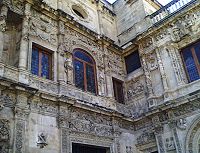
Diego de Riaño
Encyclopedia

Spanish architecture
Spanish architecture refers to architecture carried out in any area in what is now modern-day Spain, and by Spanish architects worldwide. The term includes buildings within the current geographical limits of Spain before this name was given to those territories...
of the Renaissance
Renaissance
The Renaissance was a cultural movement that spanned roughly the 14th to the 17th century, beginning in Italy in the Late Middle Ages and later spreading to the rest of Europe. The term is also used more loosely to refer to the historical era, but since the changes of the Renaissance were not...
. He was one of the most outstanding architects of the Plateresque
Plateresque
Plateresque, meaning "in the manner of a silversmith" , was an artistic movement, especially architectural, traditionally held to be exclusive to Spain and its territories, which appeared between the late Gothic and early Renaissance in the late 15th century, and spread over the next two centuries...
style.
He was born at Riaño
Riaño
Riaño may refer to one of the following places in Spain:*Riaño, León, in the province of León*Riaño, a locality of the municipality of Valle de Valdebezana*Riaño, a locality of the municipality of Solórzano...
, in Cantabria
Cantabria
Cantabria is a Spanish historical region and autonomous community with Santander as its capital city. It is bordered on the east by the Basque Autonomous Community , on the south by Castile and León , on the west by the Principality of Asturias, and on the north by the Cantabrian Sea.Cantabria...
, and is documented in Seville
Seville
Seville is the artistic, historic, cultural, and financial capital of southern Spain. It is the capital of the autonomous community of Andalusia and of the province of Seville. It is situated on the plain of the River Guadalquivir, with an average elevation of above sea level...
starting from 1523. In 1527 he commenced the Collegiate of Valladolid
Valladolid
Valladolid is a historic city and municipality in north-central Spain, situated at the confluence of the Pisuerga and Esgueva rivers, and located within three wine-making regions: Ribera del Duero, Rueda and Cigales...
and later was director of the works of the Cathedral of Seville, until his death in 1534. He also worked at the University of Osuna
University of Osuna
The University of Osuna , officially the Colegio-Universidad de la Purísima Concepción en Osuna was a university in Osuna, Kingdom of Seville, Spain from 1548 until 1824. Spain granted the university building the status of a monument in 2004...
.
Works
His works include:- Casa consistorial, SevilleCasa consistorial de SevillaThe Casa consistorial de Sevilla is a Plateresque-style building in Seville, Spain, cirrently home of the city's government .The building has a large façade divide into five modules, decorated by Plateresque reliefs...
- Sacristía de los Cálices, also in Seville
- Four chapels at the choir of the Cathedral of Seville
- Plans of the Cathedral of ValladolidCathedral of ValladolidThe Cathedral of Our Lady of the Holy Assumption , better known as Valladolid Cathedral, is a Roman Catholic cathedral in Valladolid, Spain...
(not constructed) - Works in the refectoryRefectoryA refectory is a dining room, especially in monasteries, boarding schools and academic institutions. One of the places the term is most often used today is in graduate seminaries...
of the JerezJerez de la FronteraJerez de la Frontera is a municipality in the province of Cádiz in the autonomous community of Andalusia, in southwestern Spain, situated midway between the sea and the mountains. , the city, the largest in the province, had 208,896 inhabitants; it is the fifth largest in Andalusia...
CharterhouseCharterhouseA Charterhouse is a Carthusian monastery. The word is derived from Chartreuse, the first monastery of the order having been established in a valley of the Chartreuse Mountains.It can refer to numerous monasteries:It can also refer to:...
, in 1533

